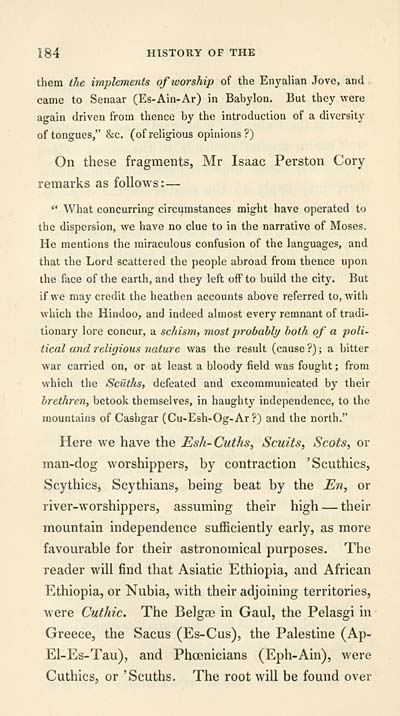Download files
Complete book:
Individual page:
Thumbnail gallery: Grid view | List view

184 HISTORY OF THE
them the implements ofivorship of the En3'alian Jove, and
came to Senaar (Es-Ain-Ar) in Babylon. But they were
again driven from thence by the introduction of a diversity
of tongues," &c. (of religious opinions?)
On these fragments, Mr Isaac Perston Cory
remarks as follows: —
" What concurring circumstances might have operated to
the dispersion, we have no clue to in the narrative of Moses.
He mentions the miraculous confusion of the languages, and
that the Lord scattered the people abroad from thence upon
the face of the earth, and they left off to build the city. But
if we may credit the heathen accounts above referred to, with
which the Hindoo, and indeed almost every remnant of tradi-
tionary lore concur, a schism, most probably both of a poli-
tical and religious nature was the result (cause ?) ; a bitter
war carried on, or at least a bloody field was fought ; from
which the Scuths, defeated and excommunicated by their
brethren, betook themselves, in haughty independence, to the
mountains of Cashgar (Cu-Esh-Og-Ar?) and the north."
Here we have the Esh-Cuths, Scuits, Scots, or
man-dog worshippers, by contraction 'Scuthics,
Scythics, Scythians, being beat by the JS?i, or
river-worshippers, assuming their high — their
mountain independence sufficiently early, as more
favourable for their astronomical purposes. The
reader will find that Asiatic Ethiopia, and African
Ethiopia, or Nubia, with their adjoining territories,
were Cuthic. The Belgse in Gaul, the Pelasgi in
Greece, the Sacus (Es-Cus), the Palestine (Ap-
El-Es-Tau), and Phoenicians (Eph-Ain), were
Cuthics, or 'Scuths. The root will be found over
them the implements ofivorship of the En3'alian Jove, and
came to Senaar (Es-Ain-Ar) in Babylon. But they were
again driven from thence by the introduction of a diversity
of tongues," &c. (of religious opinions?)
On these fragments, Mr Isaac Perston Cory
remarks as follows: —
" What concurring circumstances might have operated to
the dispersion, we have no clue to in the narrative of Moses.
He mentions the miraculous confusion of the languages, and
that the Lord scattered the people abroad from thence upon
the face of the earth, and they left off to build the city. But
if we may credit the heathen accounts above referred to, with
which the Hindoo, and indeed almost every remnant of tradi-
tionary lore concur, a schism, most probably both of a poli-
tical and religious nature was the result (cause ?) ; a bitter
war carried on, or at least a bloody field was fought ; from
which the Scuths, defeated and excommunicated by their
brethren, betook themselves, in haughty independence, to the
mountains of Cashgar (Cu-Esh-Og-Ar?) and the north."
Here we have the Esh-Cuths, Scuits, Scots, or
man-dog worshippers, by contraction 'Scuthics,
Scythics, Scythians, being beat by the JS?i, or
river-worshippers, assuming their high — their
mountain independence sufficiently early, as more
favourable for their astronomical purposes. The
reader will find that Asiatic Ethiopia, and African
Ethiopia, or Nubia, with their adjoining territories,
were Cuthic. The Belgse in Gaul, the Pelasgi in
Greece, the Sacus (Es-Cus), the Palestine (Ap-
El-Es-Tau), and Phoenicians (Eph-Ain), were
Cuthics, or 'Scuths. The root will be found over
Set display mode to: Large image | Transcription
Images and transcriptions on this page, including medium image downloads, may be used under the Creative Commons Attribution 4.0 International Licence unless otherwise stated. ![]()
| Early Gaelic Book Collections > Blair Collection > History of the Celtic language > (190) |
|---|
| Permanent URL | https://digital.nls.uk/76180699 |
|---|
| Description | A selection of books from a collection of more than 500 titles, mostly on religious and literary topics. Also includes some material dealing with other Celtic languages and societies. Collection created towards the end of the 19th century by Lady Evelyn Stewart Murray. |
|---|
| Description | Selected items from five 'Special and Named Printed Collections'. Includes books in Gaelic and other Celtic languages, works about the Gaels, their languages, literature, culture and history. |
|---|

